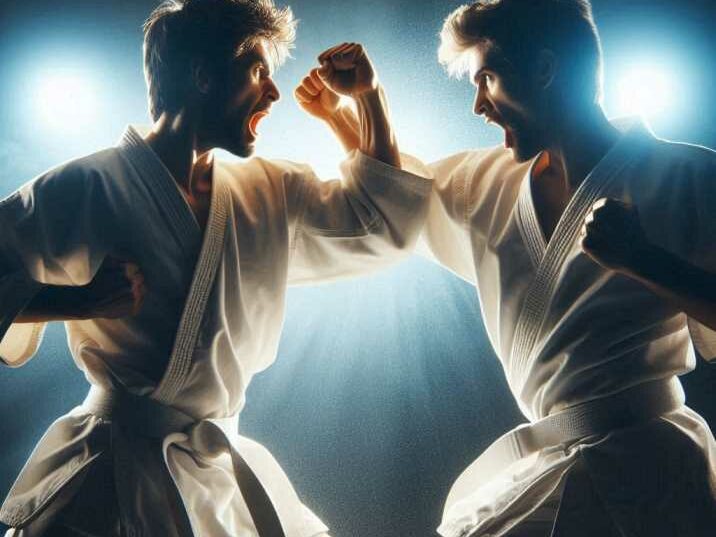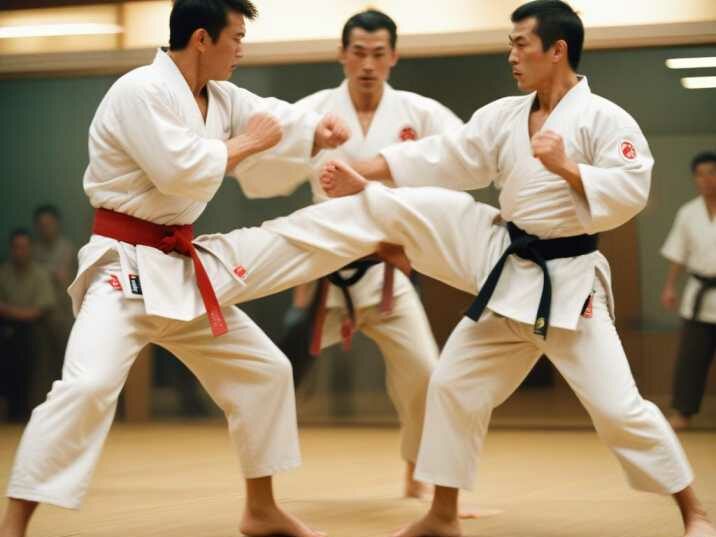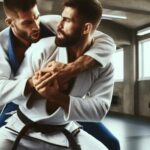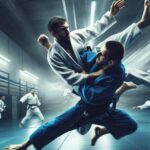Introduction
Table of Contents
Have you ever wondered what sets Kyokushin Karate apart from Shotokan Karate? Both styles are popular and offer unique techniques and philosophies, but how do you choose which one is right for you? In this blog post, we will explore the differences between Kyokushin vs Shotokan Karate, helping you understand their histories, techniques, training methods, and applications. By the end, you’ll have a clear understanding of which style may better suit your interests and goals.
Table of Contents
- History and Origins
- Fundamental Principles
- Training Methods
- Kata (Forms) Comparison
- Sparring Techniques
- Belt Ranking System
- Physical Conditioning
- Mental Discipline
- Self-Defense Applications
- Competitions and Tournaments
- Choosing the Right Style
- FAQs
History and Origins
Kyokushin Karate
Kyokushin, which means “ultimate truth,” was founded by Masutatsu Oyama in 1964. Oyama, originally from Korea, moved to Japan and trained in various martial arts before creating his unique style. Kyokushin is known for its rigorous training methods and full-contact sparring, emphasizing discipline, strength, and endurance.

Shotokan Karate
Shotokan Karate was developed by Gichin Funakoshi in the early 20th century. Funakoshi, often referred to as the father of modern Karate, introduced this style to Japan from Okinawa. Shotokan emphasizes deep stances, powerful strikes, and a strong focus on kata (forms). It is known for its traditional approach and philosophical teachings.
Fundamental Principles of Kyokushin Karate
Kyokushin Karate is a form of martial arts founded by Masutatsu Oyama in 1964, which is renowned for its emphasis on physical strength, full contact sparring, and endurance. These principles are crucial for practitioners to develop both physically and mentally. Below is a detailed explanation of each principle:
1. Physical Strength
Building a Strong Body through Intense Training
Kyokushin Karate places a significant emphasis on physical conditioning. The training routines are designed to build strength, power, and resilience. Here are some key aspects:
- Strength Training: Practitioners engage in various strength training exercises such as weightlifting, bodyweight exercises (push-ups, sit-ups, squats), and resistance training. These exercises target different muscle groups, enhancing overall muscular strength and explosiveness.
- Conditioning Drills: Techniques like makiwara (striking post) training are used to harden the fists, shins, and other striking surfaces. This not only builds strength but also prepares the body for the impact of strikes.
- Flexibility and Agility: Stretching and flexibility exercises are incorporated to improve the range of motion and agility, which are essential for executing powerful and precise techniques.
- Diet and Nutrition: A balanced diet rich in protein, vitamins, and minerals supports muscle growth and recovery, ensuring that practitioners can train at high intensity.
2. Full Contact Sparring
Practicing Realistic Combat Scenarios
Kyokushin Karate is known for its realistic and intense sparring sessions. Full contact sparring is a cornerstone of the training, providing numerous benefits:
- Realistic Experience: Unlike point-based sparring, full contact sparring simulates real-life combat scenarios. Practitioners learn how to handle physical confrontation effectively.
- Techniques Under Pressure: Sparring under full contact conditions helps practitioners learn to execute techniques with precision and control under pressure, developing practical fighting skills.
- Pain Tolerance: Regular engagement in full contact sparring builds a higher threshold for pain and discomfort, crucial for both physical and mental resilience in combat situations.
- Strategic Thinking: Practitioners learn to read their opponents, anticipate moves, and strategize accordingly. This sharpens their mental acuity and decision-making skills during a fight.
3. Endurance
Developing Stamina and Perseverance
Endurance is a vital principle in Kyokushin Karate, reflecting both physical stamina and mental fortitude:
- Cardiovascular Training: Activities such as running, jumping rope, and high-intensity interval training (HIIT) are incorporated to enhance cardiovascular fitness. This ensures that practitioners can sustain high levels of activity over extended periods.
- Rigorous Training Routines: The training sessions in Kyokushin Karate are designed to be intense and demanding. This includes long sparring sessions, kata (forms) practice, and continuous drills that test and improve endurance.
- Mental Toughness: Endurance training in Kyokushin is not just about physical stamina but also about developing mental resilience. Practitioners are taught to push beyond their perceived limits, cultivating a mindset of perseverance and determination.
- Recovery and Rest: Proper rest and recovery are emphasized to allow the body to heal and build endurance gradually. Techniques like controlled breathing and meditation are also practiced to enhance recovery and mental clarity.
Fundamental Principles of Shotokan Karate
Shotokan Karate is one of the most traditional and widely practiced styles of karate, founded by Gichin Funakoshi. The principles of Kata and Form, Distance and Timing, and Speed and Power are fundamental to the practice and philosophy of Shotokan. Below is a detailed explanation of each principle:
1. Kata and Form
Mastery of Precise and Deliberate Movements
Kata, which means “form” or “pattern,” is a series of predetermined movements that represent various offensive and defensive postures and techniques. Mastery of kata is essential in Shotokan Karate for several reasons:
- Technique Refinement: Practicing kata helps students perfect their techniques. Each movement is performed with precision, focusing on proper form, stance, and execution. This repetitive practice ensures that techniques become second nature.
- Muscle Memory: The repetition of kata movements ingrains them into the practitioner’s muscle memory. This means that in a real-life self-defense situation, the techniques can be executed instinctively.
- Flow and Transition: Kata teaches the fluid transition between techniques. Practitioners learn to move seamlessly from one position to another, which is crucial for effective combat.
- Mental Discipline: Kata requires intense focus and concentration. Practitioners must visualize opponents and scenarios, enhancing their mental discipline and situational awareness.
- Cultural and Philosophical Connection: Kata embodies the traditional values and philosophies of karate. Practicing kata connects students with the history and cultural heritage of Shotokan Karate, fostering respect and appreciation for the art.
2. Distance and Timing
Effective Management of Space and Timing Between Opponents
In Shotokan Karate, managing distance (maai) and timing (ma) is crucial for effective technique execution and self-defense:
- Optimal Distance: Practitioners learn to maintain the ideal distance from their opponents. This involves staying far enough to avoid being hit but close enough to launch a counter-attack. Understanding and controlling distance prevents unnecessary exposure to attacks.
- Timing and Rhythm: Effective timing involves executing techniques at the precise moment when an opponent is most vulnerable. This can mean striking as the opponent begins their attack or during a moment of imbalance. Mastering timing disrupts the opponent’s rhythm and creates openings for counter-attacks.
- Spatial Awareness: Practitioners develop an acute sense of spatial awareness. This includes understanding their own range and the opponent’s reach, which helps in making strategic decisions during a confrontation.
- Defensive and Offensive Balance: Managing distance and timing effectively ensures a balance between defense and offense. Practitioners learn to evade or block attacks while positioning themselves to deliver effective counter-strikes.
- Real-Life Application: These skills are critical in real-life self-defense situations where quick and efficient movement can make the difference between safety and harm. Training in distance and timing prepares practitioners to respond swiftly and effectively under pressure.
3. Speed and Power
Combining Rapid Movements with Powerful Strikes for Maximum Impact
Speed and power are fundamental to the effectiveness of Shotokan Karate techniques:
- Explosive Speed: Practitioners are trained to move quickly and efficiently. This involves rapid execution of strikes, blocks, and movements. Speed in technique execution can overwhelm opponents and reduce their ability to react.
- Generating Power: Power in Shotokan Karate comes from the proper use of body mechanics, including hip rotation, core strength, and precise technique. Techniques are executed with kime (focus), where all the energy is concentrated into a single point at the moment of impact.
- Synchronization: Speed and power must be synchronized. Fast techniques without power are ineffective, and powerful techniques without speed can be easily anticipated and blocked. The combination of both ensures that strikes are both quick and impactful.
- Breathing and Relaxation: Proper breathing techniques and relaxation of muscles until the moment of impact are essential for generating speed and power. This prevents unnecessary tension, allowing for smoother and faster movements.
- Training Drills: Specific drills, such as bag work, pad training, and sparring, are used to develop and enhance speed and power. These drills focus on explosive movements and accurate, forceful strikes.
- Efficiency and Effectiveness: The ultimate goal is to make techniques as efficient and effective as possible. By combining speed and power, practitioners can deliver decisive strikes that incapacitate opponents swiftly and efficiently.
Shotokan Karate Training Methods
Shotokan Karate training emphasizes precision, technique, and mental discipline. Here are the key components:
1. Kihon (Basics)
Repetition of Fundamental Techniques
- Technique Perfection: Practitioners focus on perfecting basic techniques through repetitive practice, ensuring correct form and powerful execution.
- Building Foundations: Kihon serves as the foundation for more advanced techniques, kata, and sparring, making it a crucial part of training.
- Consistency: Regular practice of kihon develops consistency and reliability in executing techniques.
- Integration with Breathing: Proper breathing techniques are emphasized to enhance the power and fluidity of movements.
2. Kata (Forms)
Practicing Set Forms Meticulously
- Precision and Detail: Each movement in a kata is performed with meticulous attention to detail, ensuring accuracy and effectiveness.
- Flow and Transition: Practitioners learn to transition smoothly between techniques, enhancing their ability to respond fluidly in combat.
- Mental Visualization: Kata practice involves visualizing opponents and scenarios, developing strategic thinking and situational awareness.
- Cultural Significance: Kata embodies the traditional values and philosophies of Shotokan Karate, fostering a deeper understanding and respect for the martial art.
3. Kumite (Sparring)
Controlled Sparring Sessions
- Technique Application: Controlled sparring allows practitioners to apply techniques learned in kihon and kata in a dynamic and interactive setting.
- Emphasis on Control: Unlike Kyokushin’s full-contact sparring, Shotokan kumite emphasizes control, precision, and timing to execute techniques effectively without causing serious injury.
- Timing and Distance: Practitioners develop a keen sense of timing and distance, crucial for effective self-defense and combat situations.
- Safe Environment: Controlled sparring provides a safe environment for learning and improving combat skills.
4. Mental Focus
Meditative Practices and Philosophy Discussions
- Meditation: Practitioners engage in meditation to develop mental clarity, focus, and inner calm, which are essential for effective karate practice.
- Philosophical Study: Discussions on karate philosophy and principles help practitioners understand the deeper meaning and values of the martial art.
- Mental Discipline: Mental focus and discipline cultivated through meditation and philosophical study translate into better performance in training and daily life.
- Holistic Development: Emphasizing mental focus ensures the holistic development of practitioners, balancing physical prowess with mental and emotional strength.
Kata (Forms) Comparison
Kyokushin vs Shotokan karate
Both Kyokushin and Shotokan Karate place a strong emphasis on kata, but their approaches and focuses differ:
- Kyokushin Kata:
- Realism and Combat Simulation: Kyokushin kata often emphasizes practical application and simulates realistic combat scenarios.
- Power and Endurance: The execution of Kyokushin kata tends to focus on power and endurance, reflecting the intense and rigorous nature of the style.
- Connection to Sparring: There is a strong connection between kata and kumite in Kyokushin, with kata movements directly influencing sparring techniques.
- Shotokan Kata:
- Precision and Detail: Shotokan kata is performed with a high degree of precision and attention to detail, emphasizing correct form and technique.
- Flow and Grace: Movements in Shotokan kata are often fluid and graceful, reflecting the art’s emphasis on balance and smooth transitions.
- Philosophical Depth: Shotokan kata often carries a deeper philosophical significance, with practitioners encouraged to understand the underlying principles and values.

Sparring Techniques
Kyokushin Sparring
Kyokushin sparring is known for its full-contact approach, focusing on real-life combat applications. Techniques highlighted in Kyokushin sparring include:
- Power Strikes: Emphasis on using the entire body to generate maximum force.
- Low Kicks: Utilizing powerful leg kicks to destabilize opponents.
- Close-Range Combat: Practicing techniques suitable for close proximity encounters.
- Blocking and Counter-attacks: Developing defensive maneuvers and quick counter-strikes.
Shotokan Sparring
Shotokan sparring, or kumite, is typically less contact-intensive but equally focused on precision and technique. Key elements of Shotokan sparring include:
- Distance Management: Maintaining an appropriate distance from opponents.
- Speed and Timing: Executing strikes and blocks with perfect timing.
- Controlled Techniques: Practicing strikes and defenses with restraint to minimize injury.
- Combination Attacks: Utilizing a series of coordinated movements to outmaneuver opponents.
Belt Ranking System
Kyokushin Belt Ranks
Kyokushin uses a belt ranking system that includes:
- Kyu Grades: Ranges from 10th kyu (white belt) to 1st kyu (brown belt).
- Dan Grades: Black belt ranks, starting from 1st dan upwards.
Shotokan Belt Ranks
Shotokan also uses a similar belt ranking system:
- Kyu Grades: From 10th kyu (white belt) to 1st kyu (brown belt).
- Dan Grades: Black belt ranks, starting from 1st dan upwards.
Physical Conditioning
Kyokushin Conditioning
Strength Training: Involves using weights and bodyweight exercises like push-ups, sit-ups, and squats to develop muscle strength and power. This builds the physical resilience necessary for the demanding techniques and full-contact sparring in Kyokushin Karate.
Cardio: Activities such as running, jumping rope, and other aerobic exercises are integral to Kyokushin conditioning, enhancing cardiovascular endurance and overall stamina, which are crucial for maintaining high energy levels during intense training sessions and sparring drills.
Shotokan Conditioning
Stretching: Daily stretching routines are essential in Shotokan to improve flexibility, which aids in executing high kicks, deep stances, and fluid movements. This also helps prevent injuries and ensures greater range of motion.
Technique Drills: Practitioners engage in repetitive practice of fundamental techniques and combinations to perfect form, increase agility, and ensure precision in their movements. This repetitive drilling helps in developing muscle memory and execution speed.
Mental Discipline
Kyokushin Mental Training
Meditation: Regular meditation sessions help clear the mind, improve concentration, and enhance focus, essential for rigorous training and combat.
Discipline: Strict training schedules and adherence to dojo rules instill a strong sense of discipline, ensuring that students stay committed and motivated.
Perseverance: Students are encouraged to push beyond their physical and mental limits, building resilience and mental toughness essential for overcoming challenges.
Shotokan Mental Training
Meditation: Incorporates Zen principles to cultivate inner peace, focus, and clarity, aiding in the overall mental and spiritual development of practitioners.
Etiquette: Emphasizes respect, humility, and proper behavior within the dojo, fostering a respectful and disciplined training environment.
Mindfulness: Encourages being fully present in every movement and technique, promoting awareness, precision, and a deeper connection to the practice.
Self-Defense Applications
Kyokushin Self-Defense
Strikes: Kyokushin emphasizes powerful punches and kicks designed to deliver maximum impact, making them highly effective in self-defense situations.
Blocks: Effective defensive maneuvers are taught to protect against various attacks, ensuring practitioners can defend themselves efficiently.
Sparring: Realistic combat scenarios through full-contact sparring prepare students for real-life confrontations, enhancing their readiness and confidence.
Shotokan Self-Defense
Strikes: Shotokan focuses on precise and effective techniques, ensuring that strikes are delivered accurately and with sufficient force to neutralize threats.
Kata Applications: Practitioners learn to apply the movements and principles from kata to real-world self-defense situations, bridging traditional forms with practical use.
Controlled Sparring: Techniques are practiced in a safe, controlled environment, allowing for the development of effective self-defense skills without the risk of serious injury.
Competitions and Tournaments
Kyokushin Competitions
Kyokushin tournaments are known for their intensity:
- Full-Contact Matches: Fighters compete without protective gear.
- Kata Competitions: Showcasing form and technique.
- International Presence: Popular worldwide with various championships.
Shotokan Competitions
Shotokan tournaments focus on both kata and kumite:
- Kata Events: Judged on form and precision.
- Point Sparring: Competitors score points for accurate techniques.
- Global Recognition: Recognized by many international Karate organizations.
Choosing the Right Style
Factors to Consider
Personal Goals: Determine what you want to achieve with Karate, whether it’s self-defense, physical fitness, competition, or personal development. Your goals will guide you in choosing the style that best suits your needs.
Training Preferences: Consider whether you prefer the intensity of full-contact sparring as in Kyokushin or the traditional forms and structured approach of Shotokan. Your preference for training methods and style will impact your overall enjoyment and commitment.
Dojo Availability: Research if there are reputable schools nearby that teach the style you are interested in. The quality and accessibility of instruction are crucial for consistent training and progression.
Practical Tips
Visit Dojos: Take the time to observe classes at different dojos. Talk to instructors and students to get a sense of the teaching style, class structure, and overall environment.
Trial Classes: Participate in trial sessions for each style you’re considering. This hands-on experience will help you gauge which style aligns with your interests and physical capabilities.
Community: Consider the dojo’s atmosphere and student camaraderie. A supportive and positive community can enhance your training experience and keep you motivated.
Final Thoughts
Both Kyokushin and Shotokan offer unique benefits. Your choice should align with your personal goals and preferences. Whether you seek intense physical conditioning or a deeper philosophical practice, there is a Karate style for you.
Conclusion
In conclusion, both Kyokushin and Shotokan Karate provide valuable lessons and skills. Understanding their differences can help you make an informed decision about which style suits you best. Remember, the most important aspect of any martial art is discipline, dedication, and continuous learning.
Ready to start your Karate journey? Join a local dojo and begin exploring the enriching world of Karate today!
FAQs
What is the main difference between Kyokushin and Shotokan Karate?
Kyokushin focuses on full-contact sparring and physical toughness, while Shotokan emphasizes form, technique, and kata.
Can beginners start with either Kyokushin or Shotokan?
Yes, both styles are suitable for beginners. It depends on your personal preference for training intensity and focus.
Is Kyokushin Karate more physically demanding than Shotokan?
Yes. Kyokushin’s rigorous conditioning and full-contact sparring can be more physically demanding.
Which style is better for self-defense?
Both styles offer effective self-defense techniques. Kyokushin’s full-contact training may provide more realistic combat experience.
How long does it take to earn a black belt in either style?
It typically takes around 5 to 7 years of consistent training to earn a black belt in either Kyokushin or Shotokan Karate.


